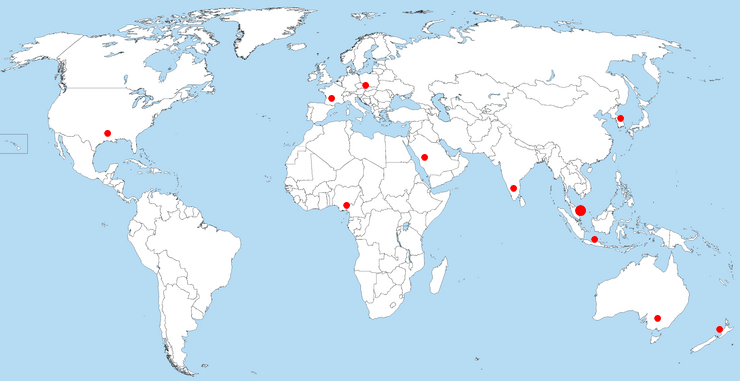FORCE AND DEFORMATION MODELING OF THE FLAPPING WING: CALLIPHORA VICINA
Keywords:
Calliphora Vicina, wing deformation, inertia, added mass, Magnus force, wing stiffness.Abstract
There is a description since several decades ago those insects have evolved that an extra lift is obtained due to the rotational and translational mechanism especially during stroke reversals. Nonetheless, this issue is strongly depending on the consequences of the wing stroke kinematics prescribed. Another issue to be concerned is the inertial force created due to the rapid acceleration or deceleration by its own distributed mass. Most people found that the force exerted to the insect’s wing mostly comes from the inertial force but no one has been able to list down all the reacted forces including aerodynamic force, Magnus force and added mass effect. Subsequently, a simulation model will be made to integrate all the relevant forces in term of magnitude and direction to find a clean single force named as a resultant force. Several years ago, majority of the wing deformation analysis discussed are base on the certain forces and none of them analyze it by considering all the forces which possibly involved. Therefore, the deformation characteristics will be calculated based on the elemental stiffness data depends on the pattern of supporting three dimensional insect's wing architecture that will be subjected to all the forces which perhaps involved. The resultant force will be accurately dispersed in spanwise direction according to chord length and the wing mass distribution in order to obtain an accurate wing deformation characteristic depending on local wing’s flexural stiffness.References
Ennos, A.R., 1988, ‘The Inertial Cause of Wing Rotation in Diptera’, The Journal of Experimental Biology, 1401, 161-169.
Dickinson, M.H, Lehmann, F.O. and Sane, S.P., 1999, 'Wing Rotation and the Aerodynamic Basis of Insect Flight', Research Articles, Science - www.sciencemag.org, 2841, 1954-1960.
Grodnitsky, D.L., 1999, 'Form and Function of Insect Wings: The Evolution of Biological Structures', The John Hopkins University Press, ISBN 0-8018- 6003-2.
Pfau H.K., 1986, 'Untersuchungen zur Konstruktion, Funktion und Evolution de Flugapprates de Libellen (Insecta, Odonata)', Tijdschr.Entomol,1293, 35- 123.
Neville A.C., 1960, 'Aspect of the flight mechanics on anisopterous dragonflies', The Journal of Experimental Biology, 37,631-656.
Hepburn, H.R. and Chander, H.D, 1976, 'Material properties of arthropod cuticles: The arthrodial membranes', J. Comp. Physiol, 109, 177-198.
Ellington, C.P., 1984, 'The aerodynamics of hovering insect flight', Phi. Tran. Roy. Soc. London, 305, 1-180.
Combes, S.A. and Daniel, T.L., 2003a, 'Flexural stiffness in insect wings I. Scaling and the influence of wing venation', The Journal of Experimental Biology, 2061, 2979-2987.
Combes, S.A. and Daniel, T.L., 2003b, 'Flexural stiffness in insect wings II. Spatial distribution and dynamic wing bending', The Journal of Experimental Biology, 2061, 2989-2997.
Ganguli, R. Lehmann, F.O. and Gorb, S., 2008, 49th
AIAA/ASME/ASCE/AHS/ASC Structures, Structural Dynamics and
Materials Conference, 7-10 April 2008, Schaumburg, Illinois, USA
Walker, J.A., 2002, 'Rotational lift: something different or more of the same', The Journal of Experimental Biology, 2051, 3783-3792.
Dickinson, M.H, 1996, ‘Unsteady mechanism of force generation in aquatic and aerial locomotion’, Am. Zool., 366, 537-540
Sane, S.P., 2003, ‘The aerodynamics of insect flight’, The Journal of Experimental Biology, 2061, 4191-4208.
Dickinson, M.H, Lehmann F.O. and Gotz, K.G., 1993, 'The active control of wing rotation by Drosophila', The Journal of Experimental Biology, 182, 173-189.
Shvets A.I., Zakharenkov M.N., Osimin, P.K., 1979, ‘Otchet Instituta Mekhaniki MGU’, Report of the Moscow University Institute of Mechanics.
Downloads
Published
How to Cite
Issue
Section
License
Copyright of articles that appear in Jurnal Mekanikal belongs exclusively to Penerbit Universiti Teknologi Malaysia (Penerbit UTM Press). This copyright covers the rights to reproduce the article, including reprints, electronic reproductions or any other reproductions of similar nature.







